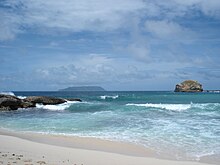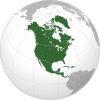Geography of Guadeloupe

The department of Guadeloupe comprises five islands: Guadeloupe island composed of Basse-Terre Island and Grande-Terre (separated from Basse-Terre by a narrow sea channel called salt river) and the dependencies composed by the adjacent French islands of La Désirade, Les Saintes and Marie-Galante. Basse-Terre has a rough volcanic relief whilst/while Grande-Terre features rolling hills and flat plains. Guadeloupe was formed from multiple volcanoes, of which only Basse-Terre is not extinct.[1]
Further to the north, Saint-Barthélemy and the French part of Saint Martin come under the jurisdiction of Guadeloupe. On December 7, 2003, both of these areas voted to become an overseas territorial collectivity.[2]
Hurricanes



The department was devastated by several hurricanes in modern times:
- On 12 September, 1928 Okeechobee hurricane caused extensive damage and killed thousands of people.
- On 22 August 1964, Guadeloupe was ravaged by Hurricane Cleo, which killed 14 people.
- Two years later, on 27 September 1966, Hurricane Inez caused extensive damage and killed 27 people, mostly in Grande-Terre. Charles De Gaulle visited the island after the hurricanes and declared it a disaster area.
- On 17 September 1989, Category 4 Hurricane Hugo caused very extensive damage, left more than 35,000 homeless, destroyed 10,000 homes, 100 percent of the banana crops, and 60 percent of the sugar cane crops.
- From late August to mid September 1995, the island was in the path of three successive cyclones: Tropical Storm Iris on 28 August caused minor damages; Hurricane Luis on 5 September caused moderate damages in north coast of Grande-Terre; Hurricane Marilyn on 15 September caused moderate damages in Basse-Terre.
- On 20 September 1998, Hurricane Georges pounded the islands, decimated the banana crops at nearly 100%.
Statistics
- Location
- Caribbean, islands in the eastern Caribbean Sea, southeast of Puerto Rico.
- Geographic coordinates
- 16°15′N 61°35′W / 16.250°N 61.583°W
- Map references
- Central America and the Caribbean
- Area
-
- Total: 1,628 km2 (629 sq mi)
- Land: 1,554 km2 (600 sq mi)
- Water: 74 km2 (29 sq mi)
- Note: Guadeloupe department is composed of six inhabited islands: the main islands which formed Guadeloupe island: Basse-Terre Island on the west and Grande-Terre on the east, and the nearby smaller islands : Marie-Galante, La Desirade, Iles des Saintes (Terre-de-Haut island and Terre-de-Bas island).
- Area – comparative
- 10 times the size of Washington, DC
- Coastline
- 306 km (190 mi)
- Maritime claims
-
- Exclusive economic zone: 200 nmi (370.4 km; 230.2 mi)
- Territorial sea: 12 nmi (22.2 km; 13.8 mi)
- Climate
- Tropical tempered by trade winds; moderately high humidity
- Terrain
- Basse-Terre is volcanic in origin with interior mountains; Grande-Terre is low limestone formation; most of the seven other islands are volcanic in origin
- Elevation extremes
-
- Lowest point: Caribbean Sea 0 m
- Highest point: La Grande Soufrière - 1,467 m (4,813 ft)
- Natural resources
- Cultivable land, beaches and climate that foster tourism
- Land use
-
- Arable land: 14%
- Permanent crops: 4%
- Permanent pastures: 14%
- Forests and woodland: 39%
- Other: 29% (1993 est.)
- Irrigated land
- 30 km2 or 12 sq mi (1993 est.)
- Natural hazards
- Hurricanes (June to October); La Grande Soufrière is an active volcano
- Environment – current issues
- NA
See also
References
![]() This article incorporates public domain material from The World Factbook. CIA.
This article incorporates public domain material from The World Factbook. CIA.

